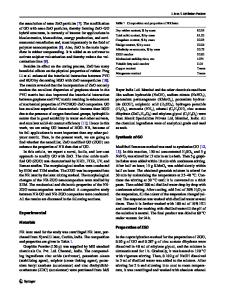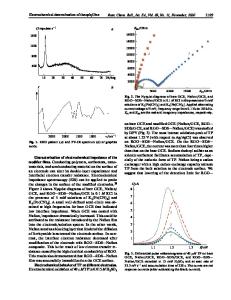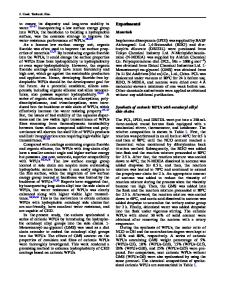Amplified cathodic electrochemiluminescence of luminol based on zinc oxide nanoparticle modified Ni-foam electrode for u
- PDF / 2,976,286 Bytes
- 12 Pages / 595.276 x 790.866 pts Page_size
- 48 Downloads / 319 Views
ORIGINAL PAPER
Amplified cathodic electrochemiluminescence of luminol based on zinc oxide nanoparticle modified Ni-foam electrode for ultrasensitive detection of amoxicillin Mohammad Ali Kamyabi 1 & Zahra Alipour 1 & Mohsen Moharramnezhad 1 Received: 11 June 2020 / Revised: 3 September 2020 / Accepted: 5 September 2020 # Springer-Verlag GmbH Germany, part of Springer Nature 2020
Abstract Here is reported a new feasible and facile method for the determination of amoxicillin by the electrochemiluminescence (ECL) method. The ECL signal was produced by the sensitive reaction between amoxicillin and luminol on the modified ZnO nanoparticle/nickel foam (ZnONP/Ni-foam) electrode. The silica film was used as a size controller template to modify the nickel foam with zinc oxide nanoparticles (ZnONPs). Electrochemiluminescence emission of luminol in the negative potential window was enhanced in the presence of the deposited nanoparticles. The characterization of the ZnONP/Ni-foam electrode was carried out with electrochemical impedance spectroscopy, X-ray diffraction analysis, field emission scanning electron microscopy, and energy-dispersive X-ray analysis. The fabricated electrode was applied for trace analysis of amoxicillin by an ultrasensitive ECL technique in the alkaline solutions. The modified electrode indicated high sensitivity toward amoxicillin under the optimal conditions in the wide linear range of 4.0 × 10−11–6.5 × 10−5 M with a low detection limit of 8.3 × 10−12 M and relative standard deviation of 1.42%. The proposed ECL-based sensor presented superior proficiency for accurate analysis of amoxicillin with high selectivity and excellent repeatability and it was successfully applied for the determination of amoxicillin in some food samples with admissible outcomes. Keywords Nickel foam . Silica template . ZnO nanoparticles . Electrochemiluminescence . luminol . Amoxicillin
Introduction Amoxicillin (AMOX) (Scheme 1) is one of the β-lactam antibiotics [1], which is easily absorbed into tissues and penetrates the central nervous system. It hinders the growth of bacteria by attaching to the cell wall of bacteria and prevents the accumulation of bacteria. It has been used to treat some infections such as acute otitis media, skin, urinary tract, salmonella, and chlamydia infections widely [2, 3]. The AMOX dosage is variable in accordance with medical conditions and response to treatment. However, when AMOX dosage is incorrectly used, it can Electronic supplementary material The online version of this article (https://doi.org/10.1007/s10008-020-04820-x) contains supplementary material, which is available to authorized users. * Mohammad Ali Kamyabi [email protected] 1
Electroanalytical Chemistry Laboratory, Department of Chemistry, Faculty of Science, University of Zanjan, Zanjan 45371-38791, Iran
be a threat to human health and cause nausea, vomiting, diarrhea, loss of appetite, and rashes [4]. Nowadays, injecting low doses of antibiotics such as AMOX to the livestock causes more production of meat or milk in a
Data Loading...











